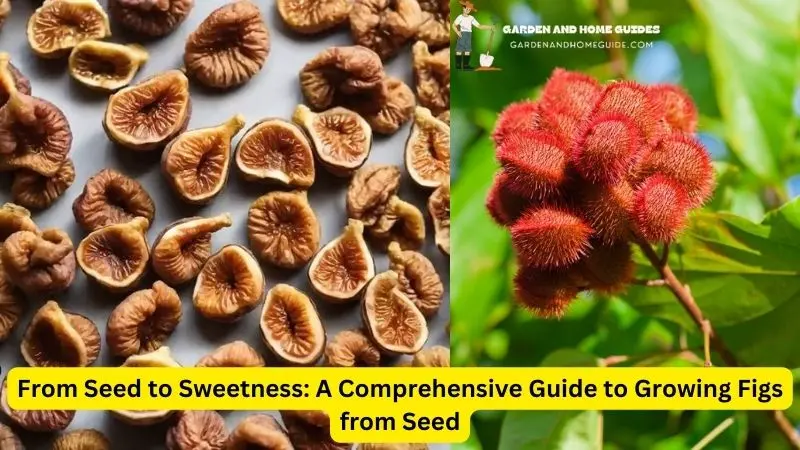Tree Care
How To Plant Figs From Seeds?
The fig, with its delicate sweetness and unique flavor, has captivated taste buds for centuries. Its cultivation, however, often involves purchasing established trees or cuttings. But for the adventurous gardener, the journey from seed to fruit offers a unique and rewarding experience.
While not the most straightforward method, growing figs from seed allows for the exploration of new varieties and the satisfaction of nurturing life from its very beginning. This essay of Gardenandhomeguide.com will guide you through the process, providing insights into the intricacies of fig seed germination, cultivation, and eventual fruiting.
The Seed: A Tiny Promise of Sweetness
The first step in this journey is obtaining viable seeds. Fresh figs, ripe and bursting with flavor, are your best bet. The seeds, nestled within the fleshy pulp, are surprisingly resilient. However, their germination rate can vary significantly depending on factors like the fig variety, ripeness of the fruit, and storage conditions.
Extracting the Seeds: A Gentle Approach
To extract the seeds, gently mash the ripe fig, separating the pulp from the seeds. This can be done by hand or using a blender, ensuring not to crush the seeds. Rinse the seeds thoroughly in a fine-mesh sieve under running water to remove any remaining pulp. Allow the seeds to air dry completely, spreading them out on a paper towel or a clean surface.
Preparing the Seeds for Germination: A Crucial Step
Fig seeds require a period of dormancy before they can germinate. This dormancy period can be broken through a process called stratification, mimicking the natural conditions they would experience in their native environment. This entails exposing the seeds to low temperatures for a considerable amount of time.
Stratification: The Key to Germination
There are two primary methods for stratifying fig seeds:
- Cold Stratification: This method involves placing the seeds in a sealed container filled with moist vermiculite or peat moss. The container is then stored in a refrigerator at a temperature between 33°F and 41°F (1°C and 5°C) for 60 to 90 days. This simulates the cold winter conditions that trigger germination in nature.
- Direct Sowing: This method involves sowing the seeds directly into a pot filled with a well-draining potting mix. The pot is then placed outdoors in a protected area where it will be exposed to the natural fluctuations of winter temperatures. This method is less controlled but can be successful in regions with cold winters.
How To Plant Figs From Seeds?
Germination: The First Signs of Life
The seeds are prepared for germination following the stratification period. Fill a seed tray or tiny pots with a well-draining potting mix. Plant the seeds ¼ inch deep and spaced by about 1 inch. Water the seeds sparingly, making sure the soil is damp but not soggy.
The Importance of Light and Temperature
The seed tray or pots should be placed in a warm, bright area. Sufficient light and steady warmth are necessary for the proper germination of fig seeds. For best growth, keep the temperature between 70°F and 80°F (21°C and 27°C).
Patience and Observation: The Waiting Game
Germination can take anywhere from a few weeks to several months, depending on the variety and the effectiveness of stratification. Be patient and observe the seeds regularly. When you see tiny green shoots emerging from the soil, you’ll know your efforts have paid off.
Transplanting the Seedlings: A New Home
The seedlings are prepared for transplanting once they have produced a few genuine leaves. In your garden, pick a sunny place or a larger pot, and make sure the soil drains well. With extreme caution to avoid damaging the fragile roots, carefully remove the seedlings from their original container. Make sure the earth covers the root ball when you plant them in their new location. After transplanting, give the area plenty of water.
Nurturing the Young Figs: A Journey of Growth
As the fig seedlings grow, they will require regular watering, fertilization, and protection from pests and diseases.
Watering: Figs need soil that drains well because they can have root rot if they receive too much water. Water the soil thoroughly but sparingly, letting it dry out a little in between applications.
Fertilizing: Because figs are voracious eaters, they require frequent fertilizing. As directed by the manufacturer, use a balanced fertilizer.
Pests and Diseases: Figs are relatively pest-resistant but can be susceptible to certain insects and diseases. Monitor your plants regularly for signs of infestation or disease and take appropriate action if necessary.
Pruning: Shaping the Future
Pruning is an essential part of fig cultivation. It helps to control the size and shape of the tree, promote fruit production, and prevent overcrowding. Prune young fig trees in the spring, removing any weak or damaged branches. As the tree matures, you can further prune to encourage fruit production on the new growth.
Fruiting: The Sweet Reward
With proper care and patience, your fig tree will eventually bear fruit. However, it can take several years for a fig tree grown from seed to produce its first fruits. The first fruits may be smaller and less flavorful than those produced by mature trees, but they are a testament to your dedication and a taste of the sweetness to come.
Beyond the Basics: Exploring the World of Figs
Growing figs from seed offers a unique opportunity to experiment with different varieties. While some varieties are known for their sweet, juicy fruits, others are prized for their unique flavor profiles or their ability to withstand colder temperatures. Researching different varieties and their specific requirements will help you choose the best option for your climate and growing conditions.
The Joy of Growing Figs: A Connection to Nature
Growing figs from seed is more than just a gardening project. It’s a journey of discovery, a connection to the natural world, and a testament to the resilience of life. From the tiny seed to the sweet fruit, each stage of the process offers a unique learning experience and a sense of accomplishment.
Conclusion: A Legacy of Sweetness
Growing figs from seed is a rewarding and fulfilling endeavor. It requires patience, dedication, and a deep appreciation for the natural world. While the process may seem daunting at first, the journey from seed to fruit is an adventure worth taking. The sweet reward of homegrown figs, bursting with flavor and nurtured with your own hands, is a testament to the power of nature and the joy of gardening.






